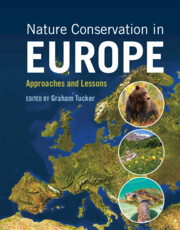Book contents
- Nature Conservation in Europe
- Nature Conservation in Europe
- Copyright page
- Dedication
- Contents
- Contributors
- Preface
- Acknowledgements
- Glossary, Abbreviations and Country Codes
- Chapter 1 Introduction: Aims, Scope, Structure and Key Information Sources
- Chapter 2 Europe’s Nature and Conservation Needs
- Chapter 3 The International Drivers of Nature Conservation, Their Objectives and Impacts on Nature Conservation Policies and Actions in Europe
- Chapter 4 Nature Conservation Policy, Legislation and Funding in the EU
- Chapter 5 Conclusions, Lessons Learnt and Implications for the Future
- Chapter 6 Austria
- Chapter 7 Belgium
- Chapter 8 Republic of Bulgaria
- Chapter 9 Republic of Croatia
- Chapter 10 Cyprus
- Chapter 11 The Czech Republic
- Chapter 12 Denmark
- Chapter 13 Estonia
- Chapter 14 Finland
- Chapter 15 France
- Chapter 16 Germany
- Chapter 17 Greece
- Chapter 18 Hungary
- Chapter 19 Ireland
- Chapter 20 Italy
- Chapter 21 Latvia
- Chapter 22 Lithuania
- Chapter 23 The Netherlands
- Chapter 24 Poland
- Chapter 25 Portugal
- Chapter 26 Romania
- Chapter 27 Slovakia
- Chapter 28 Slovenia
- Chapter 29 Spain
- Chapter 30 Sweden
- Chapter 31 United Kingdom
- Appendix Habitats Directive Annex I Habitat Types Referred to in This Book
- Index
- References
Chapter 12 - Denmark
Published online by Cambridge University Press: 11 May 2023
- Nature Conservation in Europe
- Nature Conservation in Europe
- Copyright page
- Dedication
- Contents
- Contributors
- Preface
- Acknowledgements
- Glossary, Abbreviations and Country Codes
- Chapter 1 Introduction: Aims, Scope, Structure and Key Information Sources
- Chapter 2 Europe’s Nature and Conservation Needs
- Chapter 3 The International Drivers of Nature Conservation, Their Objectives and Impacts on Nature Conservation Policies and Actions in Europe
- Chapter 4 Nature Conservation Policy, Legislation and Funding in the EU
- Chapter 5 Conclusions, Lessons Learnt and Implications for the Future
- Chapter 6 Austria
- Chapter 7 Belgium
- Chapter 8 Republic of Bulgaria
- Chapter 9 Republic of Croatia
- Chapter 10 Cyprus
- Chapter 11 The Czech Republic
- Chapter 12 Denmark
- Chapter 13 Estonia
- Chapter 14 Finland
- Chapter 15 France
- Chapter 16 Germany
- Chapter 17 Greece
- Chapter 18 Hungary
- Chapter 19 Ireland
- Chapter 20 Italy
- Chapter 21 Latvia
- Chapter 22 Lithuania
- Chapter 23 The Netherlands
- Chapter 24 Poland
- Chapter 25 Portugal
- Chapter 26 Romania
- Chapter 27 Slovakia
- Chapter 28 Slovenia
- Chapter 29 Spain
- Chapter 30 Sweden
- Chapter 31 United Kingdom
- Appendix Habitats Directive Annex I Habitat Types Referred to in This Book
- Index
- References
Summary
The chapter describes the main nature conservation challenges in Denmark, its main policy responses and actions, and their achievements and lessons, primarily over the last 40 years. This covers the country’s natural characteristics, habitats and species of particular importance; the status of nature and main pressures affecting it; nature conservation policies (including biodiversity strategies), legislation, governance and key actors; species measures; protected areas and networks (e.g. in relation to the Green Map of Denmark); general conservation measures (e.g. development planning, and restoration of the river Skjern Å); nature conservation costs, economic benefits and funding sources; and biodiversity monitoring. Likely future developments are also identified. Conclusions are drawn on what measures have been most effective and why, and what is needed to improve the implementation of existing measures and achieve future nature conservation goals.
Keywords
- Type
- Chapter
- Information
- Nature Conservation in EuropeApproaches and Lessons, pp. 254 - 272Publisher: Cambridge University PressPrint publication year: 2023

